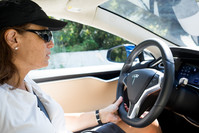Residents declare it’s a road to ruin
It could be the bumpiest ride in the Bronx.
Roads resembling Swiss cheese are the curse of Riverdale, says Teena Lerner. And while some homeowners say they prefer their roads rough to keep out traffic, Lerner — who lives on Independence Avenue not far from Wave Hill — claims she and her neighbors pay upward of $20,000 a year, per home, in real estate taxes. And most would prefer safe, smooth roads for their own cars, and for school buses and commuters.
“We’re very much over the ‘quaintness and charm of the country road’ aspect,” Lerner said, driving her Tesla down a jarring strip of Independence.
Epitomizing the issue for Lerner is a section of the avenue north of West 249th Street, where she identifies a “line of demarcation.” The roadway to its south is newly repaved, Lerner said, but north of it is old, broken and pitted.
It’s a road used by school buses transporting students to Riverdale Country School on Fieldston Road and SAR Academy on West 254th, as well as Metro-North commuters.
“It’s unbelievable that we have roads like that in New York City,” Lerner said. “Big potholes, broken up, haven’t been maintained in years.”
But her complaints to the city’s transportation department have proved futile. The main roadblock seems to be that no one can figure out who owns that and other neglected roads in the area, making it unclear who’s responsible for fixing them.
“They’re sort of like orphan roads,” said Miles Burnett, spokesman for Councilman Andrew Cohen. “The city doesn’t have ownership, and that probably goes way, way back.”
Transportation borough commissioner Nivardo Lopez couldn’t solve the mystery, either.
“It is our understanding that no one has legal title to this section of Independence Avenue,” Lopez told Lerner, but if the road has potholes or other defects, he offered to send the department’s roadways unit to repair what they could.
That wasn’t quite the answer Lerner was looking for. “It’s like … the city says ‘Well, we would do it, but we can’t.’
“Why can’t you?”
Because the city doesn’t have to, said architect Michael Goldblum, Lerner’s neighbor and commissioner of the city’s Landmarks Preservation Commission.
“New York City has no responsibility for taking care of (those roads) because they don’t belong to them,” Goldblum said. “Legally speaking, they’re in a limbo kind of state,” meaning the city provides some services — like plowing, trash collection and repair — but not full repaving.
Which leaves homeowners three options, Goldblum said. They could either settle for pothole patching the city already provides, pay for repaving out of their own pockets, or ask the city to change its policy to pay for paving streets it doesn’t own.
Yet, it’s not exactly a scandal the city isn’t rushing to repair the roads, Goldblum said. “The roads are passable. A fire truck and emergency vehicles can go down those roads, and they do all the time.”
Plus, things could be much worse.
“It’s not like East 23rd Street,” Goldblum said. “Part of the reason is because Riverdale is the product of subdivision of large rural estates of rich people in the late 19th century, early 20th century.”
Homeowners must realize what could happen if the city takes charge, Goldblum said. Along with repaving could come sidewalks, bike lanes, wider streets — many features residents might feel are antithetical to the quality of Riverdale as they see it today.
“I’d like it if (roads) were paved,” he said. “However, for the public, I think it’s important that when you ask for something, you understand what you’re asking for.”
Indeed, changes could be as jarring as the roads themselves, Joshua Stephenson — Cohen’s constituent services director — told Lerner.
“This is where you open up a Pandora’s box,” Stephenson said. Once vested to the city, all the streets would have to be made a standard 60 feet wide, with sidewalks, publicly accessible parking, and potentially alternate side parking — in an area from which Cohen’s office already receives a barrage of parking-related complaints.
Furthermore, any homeowners encroaching onto the 60-foot width would have to retract their lot lines, Stephenson said, while homeowners without sidewalks would have to pay for their installation.
The transportation department “won’t pick up ownership of the street unless they’re allowed to standardize the street,” Stephenson said.
An alternative would be something called strip-paving which, according to a transportation department spokesperson, is done by the same crews that repave streets and repair potholes. Work depends on temperature and weather conditions, as well as availability, since city-owned streets would get preference.
Lerner’s less interested in technicalities, and she’s over the red tape. What she really wants is a smoother ride when she’s cruising down Independence.
“All I can say is that this is extremely unfair and inconsistent,” Lerner said. “I feel like (the transportation department) is deliberately putting us in a Catch-22 situation, offering a ‘solution’ that is impossible to implement or accept.
“Our properties are some of the highest taxed lots in New York City. We deserve decent streets that don’t damage our cars every day.”









